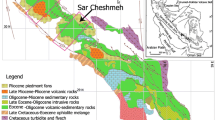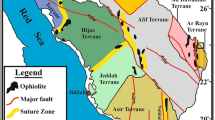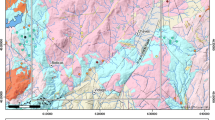Abstract
This paper focused on the detection of alteration zones associated with the hydrothermal gold deposit using Landsat 8 OLI image data. In this paper, the hydrothermal alteration zones in the study area were detected from visible–near-infrared (VNIR) and shortwave infrared (SWIR) bands of Landsat 8 OLI image data. One of the important issues for detecting hydrothermal alteration zones is to reduce the effects of the vegetation spectrum that affects the spectral feature extraction of the hydrothermally altered minerals in the relatively dense cover area. In this paper, we extracted the feature of the vegetation spectrum in the area using normalized difference vegetation index (NDVI) and mixture tuned matched filtering (MTMF) technique, then subtracted the corresponding vegetation abundance from the image pixel spectrum, finally we obtained the image with reduced vegetation effects. In the study area, the mapped hydrothermal alteration zones are mainly regions with high content of iron oxide and clay minerals and these are regions closely associated with hydrothermal mineralization. Crosta technique was used for mapping these altered zones. In this paper, principal component analysis (PCA) was carried out by selecting Landsat 8 OLI bands 2, 4, 5, 6 for mapping iron oxides and Landsat 8 OLI bands 2, 5, 6, 7 for mapping clay minerals. These alteration zones including the iron oxides and clay minerals in the study area were clearly represented in the generated images. These alteration zones are valuable for prospecting the gold deposit based on the ore geological characteristics of this area.








Similar content being viewed by others
References
Amer, R., Kusky, T., & Mezayen, A. E. (2012). Remote sensing detection of gold related alteration zones of Um Rus Area, Central Eastern Desert of Egypt. Advances in Space Research, 49, 121–134.
Atapour, H., & Aftabi, A. (2007). The geochemistry of Gossans associated with Sarcheshmeh porphyry copper deposit, Rafsanjan, Kerman, Iran: Implications for exploration and the environment. J. Geochem. Explorat, 93, 47–65.
Aydal, D., Ardal, E., & Dumanlilar, O. (2007). Application of the Crosta technique for alteration mapping of granitoidic rocks using ETM + data: Case study from eastern Tauride belt (SE Turkey). International Journal of Remote Sensing, 28(17), 3895–3913.
Bin, Hu., et al. (2018). Hydrothermally altered mineral mapping using synthetic application of Sentinel-2A MSI, ASTER and Hyperion data in the Duolong area. Tibetan Plateau. China. Ore Geology Reviews, 101, 384–397.
Boardman, J. W., & Kruse, F. A. (2011). Analysis of imaging spectrometer data using N-dimensional geometry and a mixture-tuned matched filtering approach. IEEE Transactions on Geoscience and Remote Sensing, 49(11), 4138–4152.
Carranza, E. J. M., & Hale, M. (2002). Mineral imaging with Landsat Thematic Mapper data for hydrothermal alteration mapping in heavily vegetated terrane. International Journal of Remote Sensing, 23, 4827–4852.
Choe, Y. D., Kim, C. S. et al. (2011). The Geological Series of Korea (4). Industrial publishing House, 48–60.
Crippen, R. E., & Blom, R. G. (2001). Unveiling the lithology of vegetated terrains in remotely sensed imagery. Photogrammetric Engineering and Remote Sensing, 67, 935–943.
Crosta, A., Moore, J. (1989). Enhancement of Landsat thematic mapper imagery for residual soil mapping in SW Minais Gerais State, Brazil: a prospecting case history in Greenstone belt terrain. In Proceedings of 7th ERIM Thematic Conference: Remote sensing for exploration geology, 1173–1187.
Fred, A. K., et al. (2015). Analysis of multispectral and hyperspectral longwave infrared (LWIR) data for geologic mapping. Proc. of SPIE, 9472, 1–10.
Feizollah, M., Taymour, E., Mehdi, H., & Ali, A. A. (2016). A Comparative Study of Landsat-7 and Landsat-8 Data Using Image Processing Methods for Hydrothermal Alteration Mapping. Resource Geology, 67(1), 72–88.
Han R.Y., et al. (2011). Geology of korea. Science and Technology Publishing House, 159–165.
Kang, P. G. (2001). Concentrated Distribution area of gold in Pyonnam metallogenic Province and it’s geological setting. Geological Prospecting, 1, 10–12.
Lei, L., Jun, Zh., Dong, J., Dafang, Zh., Lamin, R., et al. (2013). Targeting Mineral Resources with Remote Sensing and Field Data in the Xiemisitai Area, West Junggar, Xinjiang, China. Remote Sens, 5, 3156–3171.
Liu, L., Zhuang, D. F., & Zhou, J. D. (2011). Alteration mineral mapping using masking and Crosta technique for mineral exploration in mid-vegetated areas: A case study in Areletuobie, Xinjiang (China). International Journal of Remote Sensing, 32, 1931–1944.
Qu, L., Han, W., et al. (2014). Estimating Vegetation Fraction Using Hyperspectral Pixel Unmixing Method: A Case Study of a Karst Area in China. IEEE JOURNAL OF SELECTED TOPICS IN APPLIED EARTH OBSERVATIONS AND REMOTE SENSING, 7(11), 4559–4565.
Mahdieh, H. Z., Majid, H. T., Francisco, V. R., & Iñaki, Y. (2014). Mineral Exploration and Alteration Zone Mapping Using Mixture Tuned Matched Filtering Approach on ASTER Data at the Central Part of Dehaj-Sarduiyeh Copper Belt. SE Iran, IEEE JOURNAL OF SELECTED TOPICS IN APPLIED EARTH OBSERVATIONS AND REMOTE SENSING, 7(1), 284–289.
Ranjbar, H., Honarmand, M., & Moezifar, Z. (2004). Application of the Crosta technique for porphyry copper alteration mapping, using ETM+ data in the southern part of the Iranian volcanic sedimentary belt. Journal of Asian Earth Sciences, 24, 237–243.
Sabins, F. F. (1999). Remote sensing for mineral exploration. Ore Geology Reviews, 14, 157–183.
Sami, O., et al. (2013). Digital image processing and geospatial analysis of landsat 7 ETM+ for mineral exploration, Abidiya area, North Sudan. INTERNATIONAL JOURNAL OF GEOMATICS AND GEOSCIENCES, 3(3), 645–658.
Tae, Y. N. (2019). Prospecting direction and distribution features of gold ore bodies in Changsan area. Geological Prospecting, 3, 19–20.
Tian, H., & JoAnne, N. (2015). Mapping hydrothermally altered rocks with Landsat 8 imagery: A case study in the KSM and Snowfield zones, northwestern British Columbia. Geological Fieldwork 2014. British Columbia Ministry of Energy and Mines, British Columbia Geological Survey Paper, 1, 103–112.
Teillet, P., Guindon, B., & Goodenough, D. (1982). On the slope-aspect correction of multispectral scanner data. Canadian Journal of Remote Sensing, 8, 84–106.
Torres-Vera, M. A., & Prol-Ledesma, R. M. (2003). Spectral enhancement of selected pixels in Thematic Mapper images of the Guanajuato district (Mexico) to identify hydrothermally altered rocks. International Journal of Remote Sensing, 24, 4357–4373.
Veraverbeke, S., Verstraeten, W. W., et al. (2010). Illumination effects on the differenced Normalized Burn Ratio’s optimality for assessing fire severity. International Journal of Applied Earth Observation and Geoinformation, 12, 60–70.
Zahra, M., Mohammad, B., & Sasan, B. (2015). Digital Image Processing and Analysis Techniques for Detection of Hydrothermal Alteration Zones: A Case Study in Siah-Jangal Area, North of Taftan Volcano, Southeastern Iran. J Indian Soc Remote Sens, 43(2), 363–377.
Zanter, K. (2015). LANDSAT 8 (L8) DATA USERS HANDBOOK. Department of the Interior U.S. Geological Survey, version 1.0, 7–13.
Zhu, j. (2012) A study on remote sensing alteration information extraction in vegetation area. Dissertation paper, 51–52.
Zhao, Zh., et al. (2008). Extraction of Mineral Alteration Zone from ETM+ Data in Northwestern Yunnan, China. Journal of China University of Geosciences, 19(4), 416–420.
Acknowledgements
The authors thank the editors and anonymous reviewers for their thorough reviews of the manuscript which helped us to improve this paper.
Author information
Authors and Affiliations
Corresponding author
Ethics declarations
Conflict of interest
No potential conflict of interest was reported by the authors.
Additional information
Publisher's Note
Springer Nature remains neutral with regard to jurisdictional claims in published maps and institutional affiliations.
About this article
Cite this article
Pak, U.S., Pak, C.U. Detection of Hydrothermal Alteration Zones using Landsat 8 OLI image: A Case Study of Gold Prospecting in Nyongwon Area, DPR Korea. J Indian Soc Remote Sens 49, 2249–2259 (2021). https://doi.org/10.1007/s12524-021-01385-8
Received:
Accepted:
Published:
Issue Date:
DOI: https://doi.org/10.1007/s12524-021-01385-8




